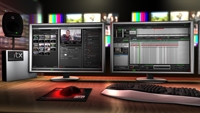Miranda Technologies acquires OmniBus Systems

Looking to help its broadcast customers bring down the cost per channel of playout and automation operations, Miranda Technologies, a provider of infrastructure, playout and monitoring systems, has purchased the assets and technology of OmniBus Systems, a maker of device automation, media management and content delivery solutions, for CDN$48.7 million (approximately $46 million).
Miranda executives said they feel they can achieve that goal for customers by combining Miranda’s playout and remote monitoring systems with the technology found in the software-driven OmniBus iTX automation system.
Palamon Capital Partners, a venture capital firm in London, owned OmniBus, and the deal has been financed with a mix of cash and credit. Based in Loughborough, UK, OmniBus Systems had revenues of approximately CDN$24 million ($23 million) for the year ending on June 30, and about $3 million in profit.
When the announcement was made last week at the IBC2010 trade show in Amsterdam, some voiced surprise at the “high” price Miranda paid, however Strath Goodship, president and CEO of Miranda Systems, said current market conditions and his perceived value of OmniBus’ intellectual property was well worth it. (He had looked at acquiring OmniBus as early as 2006, although “expectations on both sides were not realistic at the time,” he said.)
“We’re comfortable with the price we paid,” he said. “We had several outside parties look at the deal, and they felt we were making a good investment as well.”
Going forward, OmniBus will operate as a separate unit of Miranda, with the current management team of Mike Oldham, CEO, and Ian Fletcher, a founder of OmniBus and its chief technology officer, continuing in those roles. At NAB 2011 in April, the OmniBus Systems name (and exhibit booth space) will give way to Miranda, but the iTX brand will remain on related software-based playout and automation modules.
OmniBus Systems, in business for 16 years, also makes traditional, hardware/software-based automation systems like the Colossus multichannel automation system. Miranda said it would support those legacy customers and attempt to transition them to the newer generation iTX architecture.
Get the TV Tech Newsletter
The professional video industry's #1 source for news, trends and product and tech information. Sign up below.
Michelle Proulx, chief technology office at Miranda, said bringing iTX into the Miranda product portfolio allows it to offer a total migration strategy for customers that goes beyond a series of boxes or software modules. And, it’s what they need, given the competitive pressure broadcasters face.
“Customers don’t have the operating capital they once did, so everyone is trying to figure out how to put more channels on the air without increasing human resources,” Proulx said. “With a solution based on iTX and our products, I can show them how to streamline the way they do things and make channel expansion as easy as adding a new software module.”
In order to help broadcasters achieve their capex goals, “it requires new equipment and new operational rules,” Proulx said. “[Broadcasters] cannot reduce their operating expenses with the kinds of playout models that exist today. That’s why the acquisition of OmniBus made a lot of sense to us. Customers are asking us for this type of solution.”
The iTX platform is now installed in dozens of facilities worldwide, including ABC, Ascent Media, AT&T, BBC, Direct TV, Discovery, E!, FOX, SkyPerfect TV, Starz, and Turner.
Goodship said that with its IT-based playout and automation solution, the iTX platform (a standard PC with a series of remotely upgradeable software modules dedicated to different tasks) helps lead broadcasters away from multivendor, hardware-based systems, toward a single fully integrated, software platform.
Today, Miranda and OmniBus share several customer sites, whereby Miranda has provided the routers and master control/branding systems, Omneon supplied the playout servers and OmniBus installed the automation piece. The iTX platform is able to do all of the above, completely in software; whereby as many as 15 racks of gear is replaced by one or two racks — with the same amount of complexity and capability.
